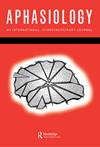失语症患者反馈学习的电生理和行为研究
IF 1.5
4区 医学
Q2 AUDIOLOGY & SPEECH-LANGUAGE PATHOLOGY
引用次数: 0
摘要
反馈是失语症治疗的一个基本方面。然而,从反馈中学习是一个认知要求很高的过程。在最基本的层面上,个体必须检测反馈并提取与结果相关的信息(即,反馈处理)。与脑卒中后失语症相关的神经解剖学和神经心理学差异可能影响反馈处理,并可能影响失语症患者对反馈治疗的反应。为了更好地理解脑卒中后失语症如何影响基于反馈的学习,本研究利用事件相关电位(erp)来(1)表征反馈加工与学习之间的关系,(2)识别与反馈加工相关的认知技能,(3)识别PWA中基于反馈的学习的行为相关因素。方法17名PWA完成基于反馈的新词学习任务。反馈处理使用反馈相关负性(FRN)来测量,这是一种假设的ERP,用于反映通过反馈传达的结果的检测和评估。受试者还完成了语言(语音处理、言语短期记忆)和执行功能的神经心理学评估。结果PWA诱发的FRN对反馈价敏感。FRN的大小与新单词学习无关,但与另一项基于反馈的任务(伯格卡排序)的表现密切相关。认知变量(信息更新、选择性注意)与新词学习相关,而语言变量与新词学习无关。讨论与结论对于PWA来说,在一些但不是所有的基于反馈的环境中,反馈处理可能与学习有关。这些发现可能为未来的研究提供信息,以确定哪些变量调节了反馈处理和学习之间的关系,并确定如何修改反馈以支持失语症康复期间的成功学习。关键词:失语反馈反馈学习事件相关电位反馈相关消极性感谢Asiya Gul在脑电数据处理方面的支持;Kesi Cania,协助处理行为数据及双重评分;感谢维多利亚·蒂尔顿·博洛夫斯基对这份手稿的反馈。感谢参与这项研究的失语症患者。披露声明作者未报告潜在的利益冲突。利益声明作者没有相关的财务或非财务利益冲突需要披露。注1为了验证该参与者没有响应偏好,我们计算了左侧和右侧目标的响应百分比。参与者在48%的时间里选择了左边的项目,在52%的时间里选择了右边的项目,这表明没有视觉不注意史引起的反应偏差为了确保延迟校正不会影响结果,对延迟和非延迟校正的数据都进行了分析。不同数据集的重要发现是相同的。为了使图更清晰,这里给出了经过延迟校正的数据。本研究得到了美国国立卫生研究院耳聋和其他交流障碍研究所的支持,研究人员分别为Sofia Vallila-Rohter [R21 DC019203]和Yael Arbel [R15 DC016438]。克里斯汀·纳恩的一部分时间也得到了退伍军人事务部学术协会办公室、匹兹堡退伍军人事务部医疗保健系统老年病学高级奖学金和匹兹堡退伍军人事务部老年病学研究、教育和临床中心(grec)的支持。内容完全是作者的责任,不代表美国国立卫生研究院,VA或美国政府的观点。本文章由计算机程序翻译,如有差异,请以英文原文为准。
An electrophysiological and behavioral investigation of feedback-based learning in aphasia
ABSTRACTIntroduction Feedback is a fundamental aspect of aphasia treatments. However, learning from feedback is a cognitively demanding process. At the most basic level, individuals must detect feedback and extract outcome-related information (i.e., feedback processing). Neuroanatomical and neuropsychological differences associated with post-stroke aphasia may influence feedback processing and potentially how people with aphasia (PWA) respond to feedback-based treatments. To better understand how post-stroke aphasia affects feedback-based learning, the current study leverages event-related potentials (ERPs) to (1) characterize the relationship between feedback processing and learning, (2) identify cognitive skills that are associated with feedback processing, and (3) identify behavioural correlates of feedback-based learning in PWA.Methods Seventeen PWA completed a feedback-based novel word learning task. Feedback processing was measured using the feedback-related negativity (FRN), an ERP hypothesized to reflect the detection and evaluation of outcomes communicated via feedback. Individuals also completed neuropsychological assessments of language (phonological processing, verbal short-term memory) and executive functioning.Results PWA elicited an FRN that was sensitive to feedback valence. The magnitude of the FRN was not associated with novel word learning but was strongly correlated with performance on another feedback-based task, the Berg Card Sort. Cognitive variables (information updating, selective attention) but not language variables were associated with novel word learning.Discussion & Conclusion For PWA, feedback processing may be associated with learning in some but not all feedback-based contexts. These findings may inform future research in determining which variables moderate the relationship between feedback processing and learning with the long-term goal of identifying how feedback can be modified to support successful learning during aphasia rehabilitation.KEYWORDS: Aphasiafeedbacklearningevent-related potentialsfeedback-related negativity AcknowledgmentsThank you, Asiya Gul, for your support with EEG data processing; Kesi Cania, for assistance with behavioural data processing and double scoring; and Victoria Tilton-Bolowsky for your feedback on this manuscript. Thank you to the individuals with aphasia who participated in this research.Disclosure statementNo potential conflict of interest was reported by the author(s).Declaration of interest statementThe authors have no relevant financial or nonfinancial conflicts of interest to disclose.Notes1 To verify that this participant did not have a response preference, we calculated the percent of responses that were for the target on the left and the right. The participant chose the item on the left 48% of the time and the item on the right 52% of the time indicating no response bias secondary to a history of visual inattention.2 To ensure that latency correction did not impact findings, analyses were run with both the latency and non-latency corrected data. Significant findings were the same across data sets. Latency corrected data is presented here for visual clarity of figures.Additional informationFundingThis work was supported by the National Institute on Deafness and Other Communication Disorders of the National Institute of Health awarded to Sofia Vallila-Rohter [R21 DC019203] and Yael Arbel [R15 DC016438]. A portion of Kristen Nunn’s time was also supported by the Department of Veterans Affairs Office of Academic Affiliations, Advanced Fellowship in Geriatrics of the Veterans Affairs Pittsburgh Health Care System and the Department of Veterans Affairs Pittsburgh Geriatric Research, Education, and Clinical Center (GRECC). The content is solely the responsibility of the authors and does not represent the views of the National Institute of Health, VA, or United States Government.
求助全文
通过发布文献求助,成功后即可免费获取论文全文。
去求助
来源期刊

Aphasiology
医学-临床神经学
CiteScore
4.40
自引率
15.00%
发文量
74
审稿时长
6-12 weeks
期刊介绍:
Aphasiology is concerned with all aspects of language impairment and disability and related disorders resulting from brain damage. It provides a forum for the exchange of knowledge and the dissemination of current research and expertise in all aspects of aphasia and related topics, from all disciplinary perspectives.
Aphasiology includes papers on clinical, psychological, linguistic, social and neurological perspectives of aphasia, and attracts contributions and readership from researchers and practitioners in speech and language pathology, neurology, neuropsychology and neurolinguistics. Studies using a wide range of empirical methods, including experimental, clinical and single case studies, surveys and physical investigations are published in addition to regular features including major reviews, clinical fora, case studies, and book reviews.
 求助内容:
求助内容: 应助结果提醒方式:
应助结果提醒方式:


